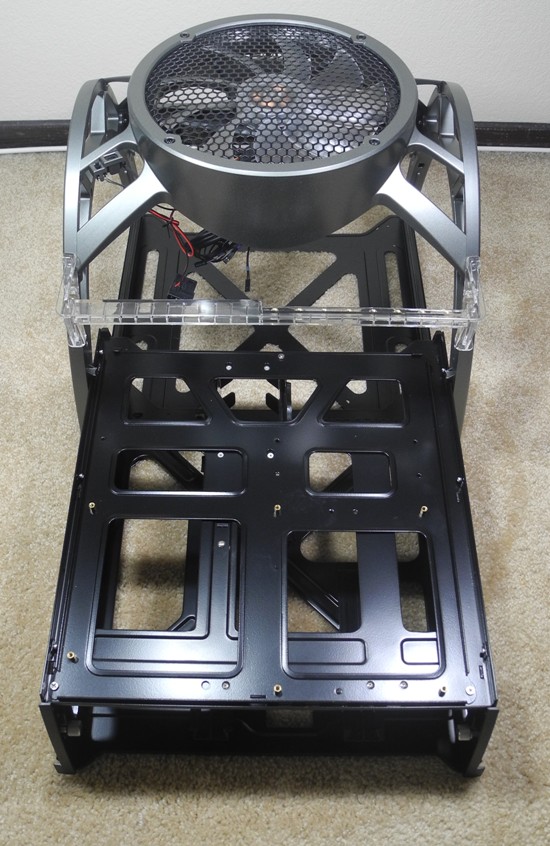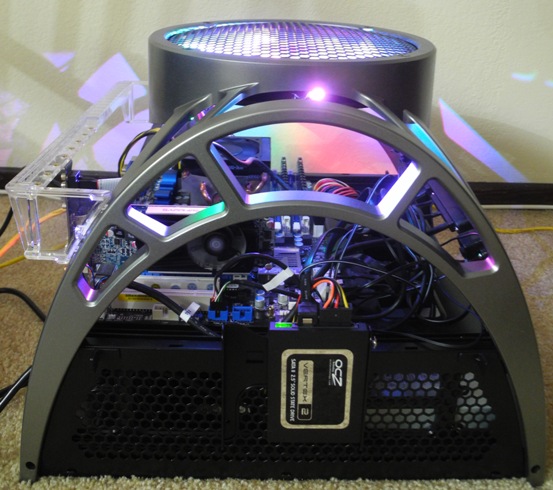AMD A8-3850 : An HTPC Perspective
by Ganesh T S on June 30, 2011 6:20 AM EST
AMD provided us with an A8-3850 CPU and an ASRock A75Pro4 ATX motherboard for the review. Purists might balk at the idea of a 100W TDP processor being used in tests intended to test the HTPC capabilities. However, we have to make do with whatever sample was sent to us. A look at the Lynx lineup indicates that the same product with a 2.6 GHz core clock (A8-3800) has a 65W TDP. I intended to underclock the CPU to 2.6 GHz. However, Llano clock adjustments are a minefield, as Ian points out in his ASRock Extreme6 review. The idle power usage in my testbed was good enough (as we shall see in a later section). My time was better spent debugging the HTPC related issues, and therefore, I didn't take the trouble to underclock.
As soon as I finished setting up the testbed, I found that Blu-rays would play correctly, but local file playback had a host of issues. Noise reduction and cadence detection wouldn't get activated for local files with ESVP on. Turning it off resulted in dropped frames and high load on the GPU. It was turning out to be very similar to the DDR3 based MSI 6450 we had reviewed earlier.
Being a new platform, BIOS updates for the ASRock A75 Pro4 were flying thick and fast. To confound the issue, different BIOS versions had different behaviors with the default UEFI settings. With some BIOS versions, even Blu-ray playback had the same issues as local files.
After going back and forth with AMD about the local file playback issue, we discovered that the BR softwares use a proprietary API for video playback from discs with DRM. For local file playback, most players use the DXVA API. These are different code paths and may result in different GPU utilization numbers.
Couple of days back, AMD finally discovered that the BIOS was forcing the shared GPU memory to an absurdly low value. The GFX memory settings forced by the user in the BIOS were also not honored. There was an update to the BIOS to fix this and set the default GFX memory to 512 MB. After this, both Blu-ray and local file playback improved enough for us to be able to get down to exhaustive testing. AMD did acknowledge that there exists an issue with local file playback having higher than normal GPU utilization, but that hasn't been resolved as yet.
The table below lists the components in our Llano HTPC testbed.
| AMD Llano HTPC Testbed Setup | |
| Processor | AMD A8-3850 - 2.90GHz, 4MB Cache (1MB/core) |
| Motherboard | ASRock A75Pro4 ATX |
| OS Drive | OCZ Vertex 2 120 GB |
| Memory | G.Skill Ripjaws Series 4GB (2 x 2GB) SDRAM DDR3 1333 (PC3 10666) F3-10666CL7D-4GBRH CAS 7-7-7-21 |
| Video Cards | None / Sapphire DDR3 6570 (for Crossfire) |
| Optical Drives | ASUS 8X Blu-ray Drive Model BC-08B1ST |
| Case | Antec Skeleton ATX Open Air Case |
| Power Supply | Antec VP-450 450W ATX |
| Operating System | Windows 7 Ultimate x64 |
| Display / AVR | Acer H243H / Onkyo TX-SR 606 + Toshiba Regza 37RV530U |
| . | |
The most important part of the testbed from a reviewer's perspective was the open air case from Antec. I had used the Antec VERIS Fusion MAX for the NAS / Fall 2010 HTPC testbed. The case was a HTPC beauty, and kept my lab neat and orderly (instead of having components all over the table and the floor). However, the fact that I had to open the case to swap PCI-E cards in and out made it slightly impractical.
The Antec Skeleton is a full ATX open air enclosure, and what really sealed the deal for me was the fact that the motherboard was easily accessible, and upto 4 SATA drives could be mounted on the side. It also has support for upto three 11" PCI-E cards. There are Quick Relase 5.25" and 3.5" bays, but I chose to mount only one optical drive in the 5.25" bay, leaving the rest open to route the cables. The four externally mounted 3.5" bays can also be used to mount 2.5" drives, as I did with the OCZ Vertex 2 SSD in the gallery below.
I keep moving my testbeds back and forth between the home theater setup with the bitstreaming / 24 Hz capable gear and the test lab upstairs with the ordinary monitors (so as to not disturb my family's usage of the HT gear). In the Antec Skeleton case, the grips on the top railing (on either side of the top fan) can be used as handles. This makes it very easy to carry around.
The fancy LED lights on top around the huge fan make it look very attractive and it is sure to turn heads.
The last thing was from an OC / gaming enthusiast viewpoint and not really from a reviewer's perspective!
Let us now proceed to the actual HTPC benchmarking of the Llano.


















104 Comments
View All Comments
Regenweald - Sunday, July 3, 2011 - link
Have to disagree with you here, technology isn't about 'points for effort' but raw performance. the Stars IPC is abysmal in comparison to SB, call it as such. In the same way In HTPC as well as 3D performance, Intel IGPs are still scraping the bottom of the barrel in comparison to the A-Series, call it as such. Which consumer buys second best because 'they're really trying' ?Lower power consumption, better performance A-Series comes out on top this time. It's ok to say it :)
garagisti - Friday, July 1, 2011 - link
Also, if you didn't find any links saying Intel supports 7.1 channel 24-bit hd audio bit-streaming over hdmi, you could have mentioned it in the review. I don't see Intel claiming it. AMD DOES feature that in their graphic parts with HD68xx series and above. I don't know if Llano features it or not, but i'd like to find out given this is a HTPC benchmark.Targon - Friday, July 1, 2011 - link
And just think about prices when HP starts releasing low-end systems with Llano. Most of us look at system prices that START at $500 and go up from there, while most end users look at the $500 mark as being near the top of what they want to spend and then go down from there.If this becomes the $400 machine, doesn't that make for a MUCH better purchase than a $500 i3 system that has similar performance numbers?
ganeshts - Friday, July 1, 2011 - link
Just a small observation that many users will be happy to invest the extra ~$100 to make sure that they can play back their $1000 1080p60 camcorder's clips.I wrote this in another comment, but I will repeat: The choice depends on what the end user wants to do with the system.
Regenweald - Sunday, July 3, 2011 - link
I'd argue that the person buying the $1000 camcorder is not looking for a sub $500 PC. For the person buying the Flip or Sanyo Xacti sub $300, Llano is their territory.ganeshts - Friday, July 1, 2011 - link
HQV testing : When the picture quality doesn't materialise for local files / local file playback has more issues with respect to higher GPU load, do you want us to recommend the system ?I respect the intelligence of the readers to the extent that they identify what is right and wrong with the hardware from what is presented.
Again, we reiterate : If you do even a bit of gaming on your PC, the Llano is a much much better bet than Intel. When it comes to HTPCs, though, take a hard look at what it does and what it doesn't. If you don't care about 1080p60 camcorder clips, then the Llano is a better choice for its 'proper' support of 23.976 Hz, and better deinterlacing capability. On the other hand, if all you play is downloaded MKVs which are progressive in nature, you will be happy with the higher CPU power provided by Intel since its iGPU is good enough in THAT scenario. All these facts are presented in the review, and it is up to the reader to see whether the pros outweigh the cons in HIS particular scenario.
As for HD audio bitstreaming, LAV Splitter + LAV Audio Decoder bitstreamed all the HD audio codecs to the AVR correctly. Proper bitstreaming support is a given in systems nowadays. In today's systems, It only deserves mention if something doesn't work. Also, I looked into AVSForum threads talking about 24-bit TrueHD streams, and many of the posters had SNB systems. Not one of them complained about any issues with HD audio bitstreaming of that content.
swaaye - Thursday, June 30, 2011 - link
Thanks for the thorough review. It gives a good overview of Lllano's virtues for video playback. Hopefully they clean up the software quickly. It's particularly annoying to see the Enforce Smooth Playback option causing problems when it has been in their drivers for year(s) now.Targon - Friday, July 1, 2011 - link
That 32nm process node has been a long time coming from AMD, hasn't it?redisnidma - Friday, July 1, 2011 - link
I'm sorry if I'm about to hurt some feelings here, but I also agree with the rest of the guys in regards to the bias in Anandtech reviews. This one about Llano is no exception.Ganesh is quick to point out that Llano doesn't offer transcoding features like Intel's Quicksync, even though he doesn't mentions that the quality output of quicksync is CRAP; but when it comes to promote a handy feature like SteadyVideo (which llano supports), he's quick to shout out to the public about the negative aspects of it.
These guys, (Anand and the bunch) are quick to criticize Llano's CPU and make a whole fuzz about it, but on the other hand they dare to call Sandybridge's iGPU as "average" and "OK" which in reality is total crap.
This site is unbelievable, but anyhow, it's good to know that people are noticing it.
ganeshts - Friday, July 1, 2011 - link
I am not a big fan of QuickSync myself (take a look at my observations in the article).IIRC, Anand's review indicated that QuickSync's output quality was much better than the GPU based encoding techniques promoted by NVIDIA. And the ATI Stream technology seemed to generate something close to the QuickSync quality, albeit with a much lower performance.
Basically, I consider QuickSync useless unless we can get the sort of quality that proper options to x264 can provide.